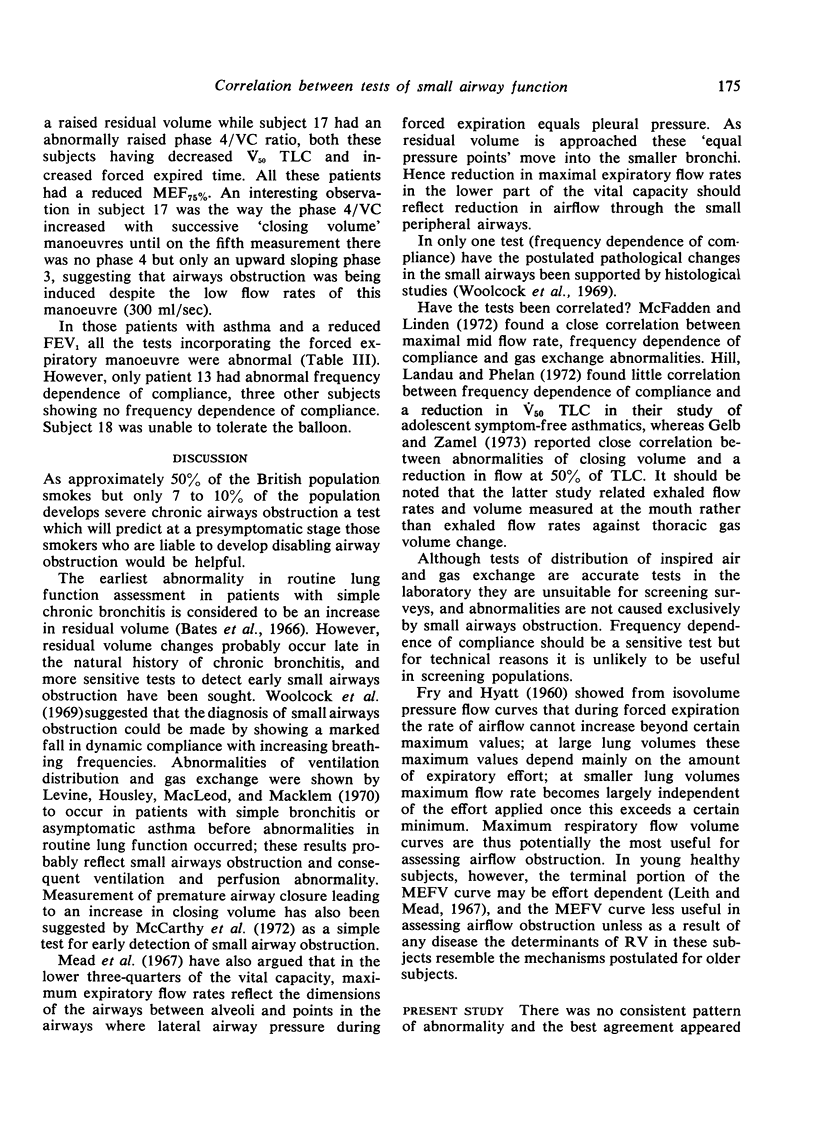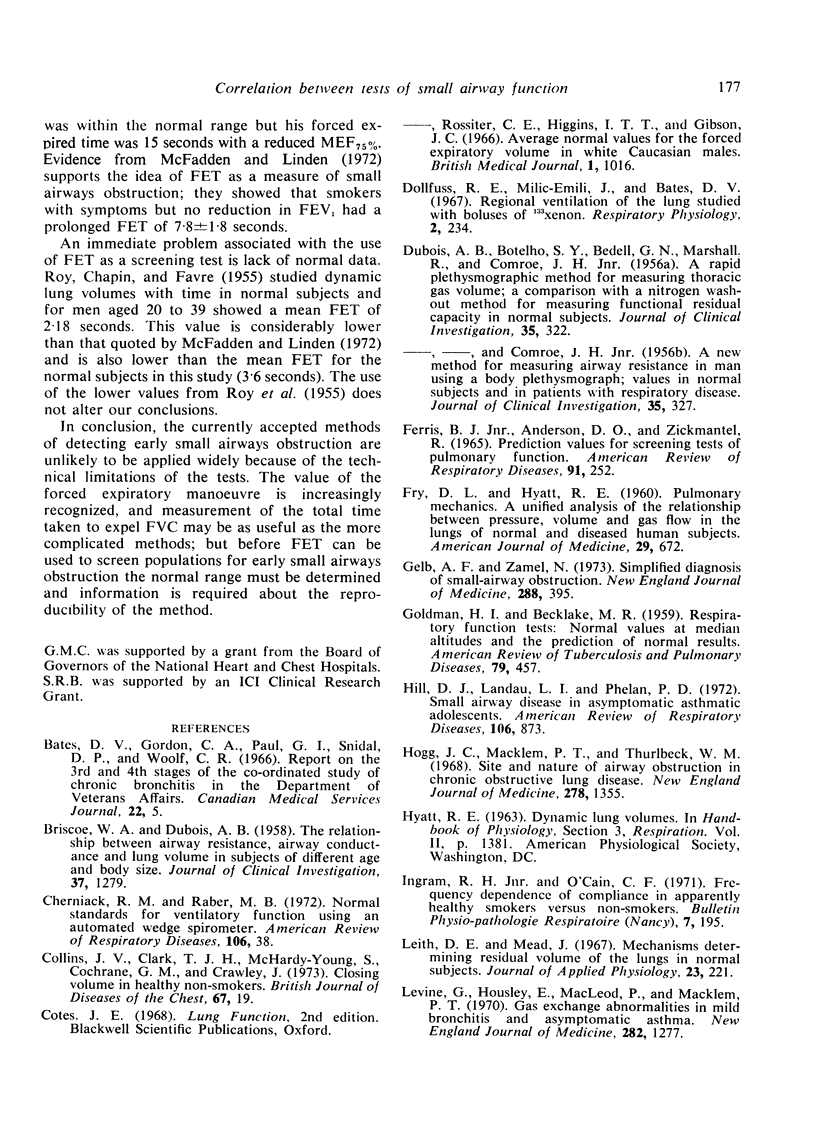Abstract
Cochrane, G. M., Benatar, S. R., Davis, J., Collins, J. V., and Clark, T. J. H. (1974.)Thorax,29, 172-178. Correlation between tests of small airway function. To compare and correlate tests of small airway function we have measured residual volume, frequency dependence of compliance, `closing volume', maximal expiratory flow rate at 50% and 25% of vital capacity, maximal expiratory flow rate at 50% of total lung capacity, and forced expired time in 10 health non-smoking male subjects and 10 non-smoking asthmatics who on the day of the study had no symptoms of airway obstruction. There was no evidence to suggest that any one particular test was more sensitive than others in detecting the presence of small airways obstruction. The closest correlation was between maximal expiratory flow rate at both 25% of vital capacity and 50% of total lung capacity and the forced expired time. It is argued that a prolonged forced expired time in the presence of normal dynamic lung volumes may be the most easily applicable screening test for early small airways obstruction.
Full text
PDF






Selected References
These references are in PubMed. This may not be the complete list of references from this article.
- BRISCOE W. A., DUBOIS A. B. The relationship between airway resistance, airway conductance and lung volume in subjects of different age and body size. J Clin Invest. 1958 Sep;37(9):1279–1285. doi: 10.1172/JCI103715. [DOI] [PMC free article] [PubMed] [Google Scholar]
- Cherniack R. M., Raber M. B. Normal standards for ventilatory function using an automated wedge spirometer. Am Rev Respir Dis. 1972 Jul;106(1):38–46. doi: 10.1164/arrd.1972.106.1.38. [DOI] [PubMed] [Google Scholar]
- Collins J. V., Clark T. J., McHardy-Young S., Cochrane G. M., Crawley J. Closing volume in healthy non-smokers. Br J Dis Chest. 1973 Jan;67(1):19–27. doi: 10.1016/0007-0971(73)90003-x. [DOI] [PubMed] [Google Scholar]
- Cotes J. E., Rossiter C. E., Higgins I. T., Gilson J. C. Average normal values for the forced expiratory volume in white Caucasian males. Br Med J. 1966 Apr 23;1(5494):1016–1019. doi: 10.1136/bmj.1.5494.1016. [DOI] [PMC free article] [PubMed] [Google Scholar]
- DUBOIS A. B., BOTELHO S. Y., BEDELL G. N., MARSHALL R., COMROE J. H., Jr A rapid plethysmographic method for measuring thoracic gas volume: a comparison with a nitrogen washout method for measuring functional residual capacity in normal subjects. J Clin Invest. 1956 Mar;35(3):322–326. doi: 10.1172/JCI103281. [DOI] [PMC free article] [PubMed] [Google Scholar]
- DUBOIS A. B., BOTELHO S. Y., COMROE J. H., Jr A new method for measuring airway resistance in man using a body plethysmograph: values in normal subjects and in patients with respiratory disease. J Clin Invest. 1956 Mar;35(3):327–335. doi: 10.1172/JCI103282. [DOI] [PMC free article] [PubMed] [Google Scholar]
- FERRIS B. G., Jr, ANDERSON D. O., ZICKMANTEL R. PREDICTION VALUES FOR SCREENING TESTS OF PULMONARY FUNCTION. Am Rev Respir Dis. 1965 Feb;91:252–261. doi: 10.1164/arrd.1965.91.2.252. [DOI] [PubMed] [Google Scholar]
- FRY D. L., HYATT R. E. Pulmonary mechanics. A unified analysis of the relationship between pressure, volume and gasflow in the lungs of normal and diseased human subjects. Am J Med. 1960 Oct;29:672–689. doi: 10.1016/0002-9343(60)90100-5. [DOI] [PubMed] [Google Scholar]
- GOLDMAN H. I., BECKLAKE M. R. Respiratory function tests; normal values at median altitudes and the prediction of normal results. Am Rev Tuberc. 1959 Apr;79(4):457–467. doi: 10.1164/artpd.1959.79.4.457. [DOI] [PubMed] [Google Scholar]
- Gelb A. F., Zamel N. Simplified diagnosis of small-airway obstruction. N Engl J Med. 1973 Feb 22;288(8):395–398. doi: 10.1056/NEJM197302222880805. [DOI] [PubMed] [Google Scholar]
- Hill D. J., Landau L. I., Phelan P. D. Small airway disease in asymptomatic asthmatic adolescents. Am Rev Respir Dis. 1972 Dec;106(6):873–880. doi: 10.1164/arrd.1972.106.6.873. [DOI] [PubMed] [Google Scholar]
- Hogg J. C., Macklem P. T., Thurlbeck W. M. Site and nature of airway obstruction in chronic obstructive lung disease. N Engl J Med. 1968 Jun 20;278(25):1355–1360. doi: 10.1056/NEJM196806202782501. [DOI] [PubMed] [Google Scholar]
- Ingram R. H., Jr, O'Cain C. F. Frequency dependence of compliance in apparently healthy smokers versus non-smokers. Bull Physiopathol Respir (Nancy) 1971 Jan-Feb;7(1):195–212. [PubMed] [Google Scholar]
- Leith D. E., Mead J. Mechanisms determining residual volume of the lungs in normal subjects. J Appl Physiol. 1967 Aug;23(2):221–227. doi: 10.1152/jappl.1967.23.2.221. [DOI] [PubMed] [Google Scholar]
- Levine G., Housley E., MacLeod P., Macklem P. T. Gas exchange abnormalities in mild bronchitis and asymptomatic asthma. N Engl J Med. 1970 Jun 4;282(23):1277–1282. doi: 10.1056/NEJM197006042822301. [DOI] [PubMed] [Google Scholar]
- MILIC-EMILI J., MEAD J., TURNER J. M., GLAUSER E. M. IMPROVED TECHNIQUE FOR ESTIMATING PLEURAL PRESSURE FROM ESOPHAGEAL BALLOONS. J Appl Physiol. 1964 Mar;19:207–211. doi: 10.1152/jappl.1964.19.2.207. [DOI] [PubMed] [Google Scholar]
- Macklem P. T., Mead J. Resistance of central and peripheral airways measured by a retrograde catheter. J Appl Physiol. 1967 Mar;22(3):395–401. doi: 10.1152/jappl.1967.22.3.395. [DOI] [PubMed] [Google Scholar]
- McCarthy D. S., Spencer R., Greene R., Milic-Emili J. Measurement of "closing volume" as a simple and sensitive test for early detection of small airway disease. Am J Med. 1972 Jun;52(6):747–753. doi: 10.1016/0002-9343(72)90080-0. [DOI] [PubMed] [Google Scholar]
- McFadden E. R., Jr, Linden D. A. A reduction in maximum mid-expiratory flow rate. A spirographic manifestation of small airway disease. Am J Med. 1972 Jun;52(6):725–737. doi: 10.1016/0002-9343(72)90078-2. [DOI] [PubMed] [Google Scholar]
- OTIS A. B., MCKERROW C. B., BARTLETT R. A., MEAD J., MCILROY M. B., SELVER-STONE N. J., RADFORD E. P., Jr Mechanical factors in distribution of pulmonary ventilation. J Appl Physiol. 1956 Jan;8(4):427–443. doi: 10.1152/jappl.1956.8.4.427. [DOI] [PubMed] [Google Scholar]
- ROY J., CHAPIN H. B., FAVRE J. Studies in pulmonary ventilatory function. I. Vital capacity, first one-second capacity, and forced respiration curves in patients with asthma; comparative evaluation of methods. J Allergy. 1955 Nov;26(6):490–506. doi: 10.1016/0021-8707(55)90090-3. [DOI] [PubMed] [Google Scholar]
- Woolcock A. J., Vincent N. J., Macklem P. T. Frequency dependence of compliance as a test for obstruction in the small airways. J Clin Invest. 1969 Jun;48(6):1097–1106. doi: 10.1172/JCI106066. [DOI] [PMC free article] [PubMed] [Google Scholar]
- Zapletal A., Motoyama E. K., Van De Woestijne K. P., Hunt V. R., Bouhuys A. Maximum expiratory flow-volume curves and airway conductance in children and adolescents. J Appl Physiol. 1969 Mar;26(3):308–316. doi: 10.1152/jappl.1969.26.3.308. [DOI] [PubMed] [Google Scholar]


